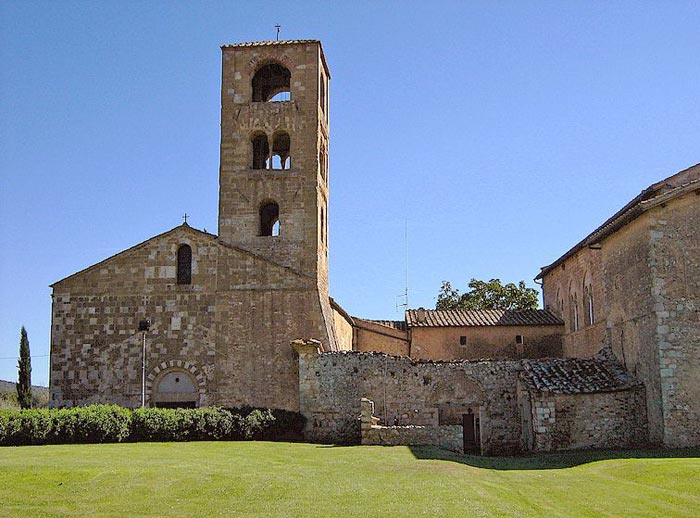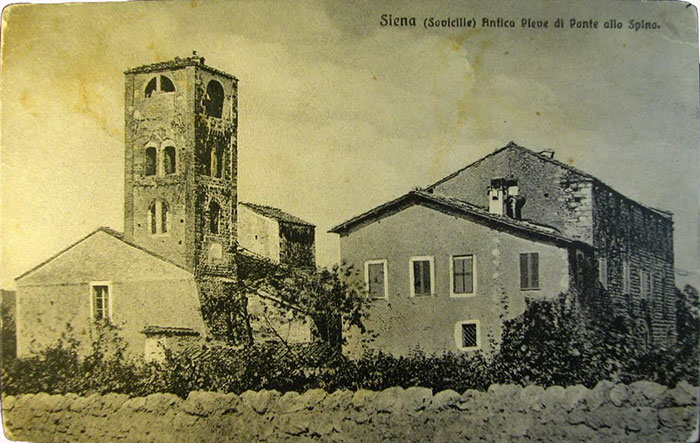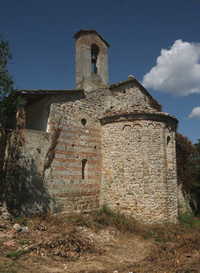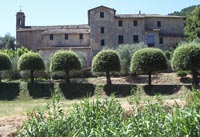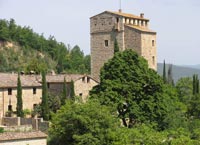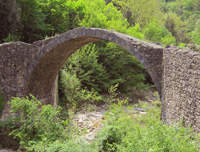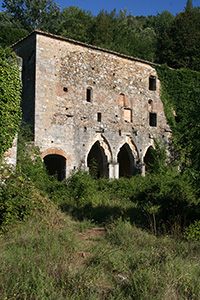Sovicille |
Sovicille is located in the Val di Merse, an area of lush forest and mediaeval villages, and has played a remarkable role in the history of Republic of Siena. The village is located about 10 km west of Siena on the old via Maremmana, the road running from Sienna to the coast of the Maremma. |
|||
The plains at the foot of the Montagnola have an intense red color due to the presence of iron and bauxite in the soil. Here it is possible to find crystals fused with black quartz and hyaline, along with crystals of hematite and calcite. There are springs at the hill slopes that are rich sources of soft drinking water. There is a large shallow underground watershed in the fiatlands in the area of the Arnpugnano airport: this Luco spring provides water to a vast district. This territory that is made up of forests, hills, and plains with streams of water running throughout them, has been inhabited from the beginning of civilization. Prehistoric findings around the areas of Trecciano and Brenna date back to the Stone Age. In various locations there are traces of Villanovan, Etruscan and Roman civilizations not to mention the great expanse in feudalism and city states. Considering the abundance of woodlands, up until the middle of the last century the main activities in this vast territory were charcoal burning and woodcutting.
|
|||
| Villa dei Pittori, also known as Villa Lechner or Villa Vecchio Maniero, is located in the small, picturesque town of Sovicille. The imposing 17th-century palazzo was built over the ruins of an ancient castle. The T-shaped palace is made up of a central body built on the ancient walls, showing a curvilinear structure, and an extended body that stretches out to the main square of the village. The part below the main building is characterized by a unique combination of particularly elegant, indented stairs that lead to the park. Still visible today are the last of the circular walls (dating from 1479) in the building, in the remaining parts to the west and in other houses (also erected upon the old walls). The elliptic structure of the central part of Sovicille proves its Etruscan origins. It was typical of this population and later of the Romans too to found their villages at watersheds on the hills for defesive reasons and also to avoid flooding and malaria. |
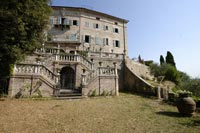 Sovicille castle - Villa Lechner Sovicille castle - Villa Lechner |
||
Pieve di Ponte allo Spino One of the main monuments of the Sovicille area is the Pieve di San Giovanni Battista, a romanesque structure with three naves. The Pieve di San Giovanni Battista is better known as the Pieve di Ponte allo Spino and was originally built in the second half of the 12 C by Vallambrosan monks and shows many similarities with contemporary French architecture.
|
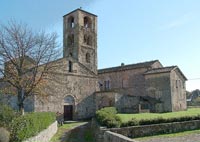 Sovicille, Pieve di San Giovanni Battista |
||
 |
|||
Pieve san Giovanni Battista a Ponte allo Spino, (interior) |
|||
|
|||
| Pieve di San Giovanni Battista a Ponte allo Spino, 1916 |
|||
| There are several occupied and also ruined Augustinian monasteries in the area, most notably the Hermitage and Monastery of the Holy Saviour at Lecceto. It is difficult to name all the castles, palaces, small churches, the tower-houses, the historical settlements spread in Sovicille area, from the tangle of forests of the Montagnola up to the valleys, Montarrenti, Palazzo al Piano, Brenna, Tonni and then San Gimignano, San Giusto a Balli, Pernina and many others. |
|||
| Cetina is an isolated hamlet on the top of the Montagnola which has now almost finished being restored after years of abbandon. La Cetina used to be divided in two: the higher and the lower part and was property of the Cardinal Chigi of Siena. There is a lovely little late romanic church that dates back to 1100 which was used as a hospice during the years of the plague. There are also two monumental chestnut trees that are hundreds of years old. Also in the area of Sovicille is the enchanting Villa di Cetinale, renowned for its elegant gardens and stunning architectural beauty. The villa dates back to 1680 and was built by Carlo Fontana to satisfy the demanding tastes of cardinal Flavio Chigi, nephew of pope Alexander VII. Another impressive building is the nearby Castle of Celsa, which was converted into a villa in the 16th century. The Italian garden is unforgettable! Both residences are privately owned and only accessible via private tour. |
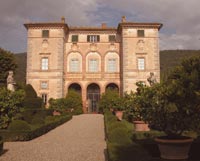 Villa di Cetinale Villa di Cetinale |
||
| Pieve di Pernina is situated in Montagnola Senese, 2 Km away from Cetinale. The ancient Romanesque building, immersed in a dense ilex's wood and presents a simple architectonical style. The etymon probably from the Etruscan Perna, in latin Pernia - Pernaia (small noble). The Pieve di Santa Maria in Pernina, built in a beautiful stone filaretto is of the XII century. It has a basilican plan with three naves, divided by four crossings that meet in one apse. A few of the capitals present decorations with geometric designs, while the bases of the semi-columns take you back to various Sienese churches. The outstanding bell tower, about 22 meters high, with a squared base and terminal battlements is situated in front of the facade of the church. |
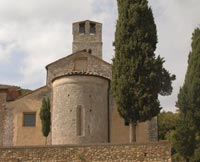 Pieve di Pernina Pieve di Pernina
| ||
| Pieve di San Giusto a Balli is situated at nord-east of Sovicille, on the right of the torrent Serpenna. This ancient Romanesque church was in origin with nave and two aisles, then was rebuilted with bricks and clear stone. At the end of the central nave there is a big apse, belonged to a previous early-Romanesque building. The small village of Torri, 14 km from Sienna, is famous for the Abbey of Santa Mustiola (Chiesa della Santissima Trinità e di Santa Mustiola) and its cloister. The Abbey, first recorded in 1070, was founded by Vallombrosan monks. The cloister is now the property of the Bicocchi family and may be visited on limited days of the week. Abazia di Santa Mustiola is an ancient monastic foundation of XII century. Actually used as villa-farm, the abbey conserves a beautiful quadrangular cloister with three superimposed orders : the ground order is Romanesque with arches sustained by pilasters; the median order is built with big octagonal pilasters; and the superior order is Renaissance with wood's columns. Castello di Poggiarello di Stigliano is a small castle and village located near Sovicille. The castle is located on the hill of Poggiarello, just above the village of Stigliano, into the Merse Valley, on the first slopes of the woody Colline Metallifere. The ancient tower and the castle enclose a space at the top of a hill, with panoramic views toward the skyline of the Siena’s towers in the foreground, and the Chianti Mountains. The history of Poggiarello reaches back at least as far as Etruscan times, shown by the remains of walled enclosures on the hill. There are traces of iron age settlements found in recent archaeological digs. Built in the 12th. C., Il Castello del Poggiarello di Stigliano served originally to protect the flourishing commercial development of the area. By the 14 C, Stigliano was probably the hub of the network of roads crossing the region, one to Massa Marittima and another following the Rosia river to the Maremma. All routes passed through the villages of Torri and Stigliano, and traces of the old roads can be seen in the woods nearby Stigliano. Hamlets such as Poggiarello were important as defense posts in the middle ages and even more so for the industrial development which flourished in the early middle ages when multi-national businesses developed. |
|||
Castello di Spannocchia is located about 12 miles southwest of Siena in central Tuscany. Castello di Spannocchia was built by the Spannocchi family in the 15 C, enlarged in the 18 C and then purchased by the Cinelli family in 1925. It includes a mediaeval tower, the original owner’s villa, and a farm, the Tenuta di Spannocchia. The Tenuta is an organic farm and forest and is part of the Region of Tuscany’s Riserva Natural Alto Merse nature reserve. |
|||
| Ponte della Pia is the most charming bridge of this area. In Etruscan times an ancient road crossed it. The bridge has probably Roman origins and it has been rebuilt during the Middle Ages in Romanic style. The bridge linked the Merse Valley to the Maremma Toscana. According to some legends, the beautiful Pia, Nello d'Inghiramo de Pannocchieschi's sorrowful wife, crossed this bridge to go into exile in Maremma, at Castello della Pietra. Dante Alighieri wrote about this legend (Divine Commedy, Purgatorio, Canto V). |
|||
| Ponte della Pia o Ponte del Diavolo. Travelling along the valley of the stream that connects Rosia to Montarrenti, almost as a mirage, the most beautiful bridge of this territory appears in a very picturesque gorge. Going over it you reach St. Lucy's hermitage and the Spannocchia castle. In Etruscan times there was a road which connected the Merse Valley with the Maremma area crossing the Montagnola area. It is presumed that the bridge has Roman origins, but only in medieval times it would have been rebuilt using Romanesque criteria. It is believed that it was reconstructed around the year 1000, for the passage of the coenobites of the hermitage. On the other side of the bridge you find the old stone paved road that had been redone around the middle of the XV c. and called the "Strata Manliana". From this bridge, we know from the legend, the beautiful Pia (unhappy wife of Nello d'Inghiramo de Pannocchieschi) passed to go into exile in Maremma, in the Castle of the Stone. Of this Dante Alighieri spoke in the Fifth canto of Purgatory: |
|||
| "Oh, when you will have come back into the world And you will have rested from the long walk, follow the third spirit, after the second, remember me, I am Pia, born in Siena and died in Maremma. How I died, he, who first gave me his ring And then married me, knows." Or in the Mandelbaum translation: |
|||
The Eremo di Rosia is situated near the medieval bridge over the River Rosia, called Ponte della Pia. The church, entitled to holy Antonio and Luca, was probably built with only nave's system but today is remained only the presbytery's and external wall's part. |
|||
The 18th century Villa Linari, or San Lorenzo a Linari, is a medieval monastery located in the wonderful Montagnola area 8 km southwest of Siena. Built in the XIth century, it was converted to a grand country 500 years later by renowned Sienese architect Baldassarre Peruzzi. La montagnola senese extends in the districts of Siena, Monteriggioni, Sovicille and Casole d'Elsa, but for the most part it is located in the district of Sovicille. |
|||
|
|||
 |
|||
One of the best places to slow travel in southern Tuscany is Podere Santa Pia. This holiday house is a peaceful retreat, offers some of the most amazing views of the Mediterranean Sea, up to the islands of Corsica and Montecristo
|
|||
| Sovicille’s territory stretches from La Montagnola Senese to the valley of the river Merse. |
|||
From Villa di Cetinale to the Pieve di Pernina |
|||
| Leaving from the Renaissance Villa di Cetinale, walking through the green woods we shall climb the Scala Santa up to the Romitorio monk residence. From here we shall see the amazing panorama and then we shall reach the Pieve romanica of Pernina and see the Celsa castle. | 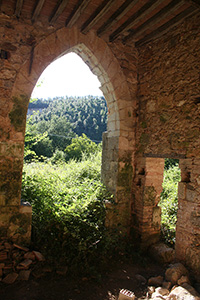 Eremo di Rosia, interior |
||
Maps: Multigraphic 509 La Montagnola Senese 1:25.000 |
|||
| Sovicille a land to discover | Itineraries | Ponte della Pia, Eremo di Santa Lucia, Castello di Spannocchia, Monte Acuto, Torri, Rosia | |||
| The Reserve, situated in the south-west of the town of Siena, includes a long stretch of the river Merse, the stream Ricausa, most part of the stream Rosia and the last stretch of the stream La Gonna, all tributaries of the river Merse. Most part of the mountains, in particular those where the siliceous rocks belonging to the Verrucano Group outcrop, is covered by deciduous woodlands where the Turkey oak dominates, since it well adapts to siliceous soils. In the lower part of the slopes, which are cooler, together with the Turkey oak we can also find the Sessile oak. After Sessile oak woods, Chestnut tree woods are the most widespread woodland habitat in the Reserve. Map |
|||
| Via Francigena | From Monteriggioni to Siena | From San Gimignano to Monteriggioni |
|||
| This 29.8 km itinerary begins in San Gimignano and takes in about 7 hours to complete. It is one of the most beautiful legs of the Via Francigena, and after the frst section of the path, you begin to walk up and down in the valley of the Foci river, near Molino d'Aiano. A path leads upward to the Romanesque church of Santa Maria a Coneo. Then you cross the bridge on the hilltop to reach the Romanesque church of San Martino di Strove. Then you go to the Abbadia Isola, before catching a sight of Monteriggioni, with its unmistakable ring of walls and towers that dominate the surrounding hills. |
|||
| Anello Sovicille | Sovicille – San Giusto – Villa Cetinale – Il romitorio di Cetinale - Pieve di Pernina – Ancaiano – Villa Celsa - 16 km (Italian) Anello Monteriggioni | Monteriggioni, Badia a Isola, Castel Petraia, Monte Maggio (Italian) Most of the itineraries around Sovicille are covered by the Carta Turistica (Turistic Maps) and by the Sentieri della Montagnola Senese 1:25000 (The Sienese Montagnola Paths) Club Alpino Italiano (CAI: Italian Alpine Club) Sezione di Siena (Multigraphic Edizioni, Firenze). |
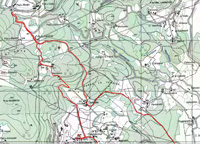
|
||
Enlarge map |
Sovicille borders Casole d'Elsa, Chiusdino, Monteriggioni, Monteroni d'Arbia, Monticiano, Murlo and Siena. Rosia, San Rocco a Pilli, Stigliano, Torri and Volte Basse are frazioni of Sovicille. |

